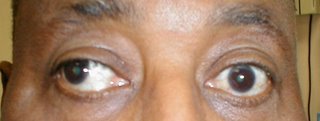Ptosis for PACES
Ptosis is often missed by PACES candidates. The sign is subtle especially if it is a partial ptosis. In PACES, ptosis carries a lot of weight in reaching the correct diagnosis in neurology station.
The common scenario would be: Please examine the patient's eyes.
The common scenario would be: Please examine the patient's eyes.
1. Look at the level of the eyelid, look for asymmetry
- Unilateral/bilateral
- Partial/complete
2. Then, proceed to check the pupil, look for anisocoria (unequal pupil)
- dilated in 3rd nerve palsy
- constricted in Horner's syndrome
- normal size pupil in MG, CPEO, dystrophy myotonica
3. Look for eye position, any strabismus
- looking downward and outward in 3rd nerve palsy
- variable strabismus in MG



Labels: Neurology








2 Comments:
Thanks eMRCPian for the ptosis tips. Just want to share. I had a short case earlier on:
50y/o lady, bilateral partial ptosis, normal pupils and normal EOM, wasting of the temporalis and frontal balding. But couldn't elicit myotonia clinically.
I thought of dystrophia myotonica straightaway. Differential being MG but less likely.
Verdict:
Fascioscapulohumeral Muscular Dystrophy
Tips: Must check upper limbs and lower limbs and look particularly for winging of scapula
more discussion in Ptosis (2)
Post a Comment
<< Home